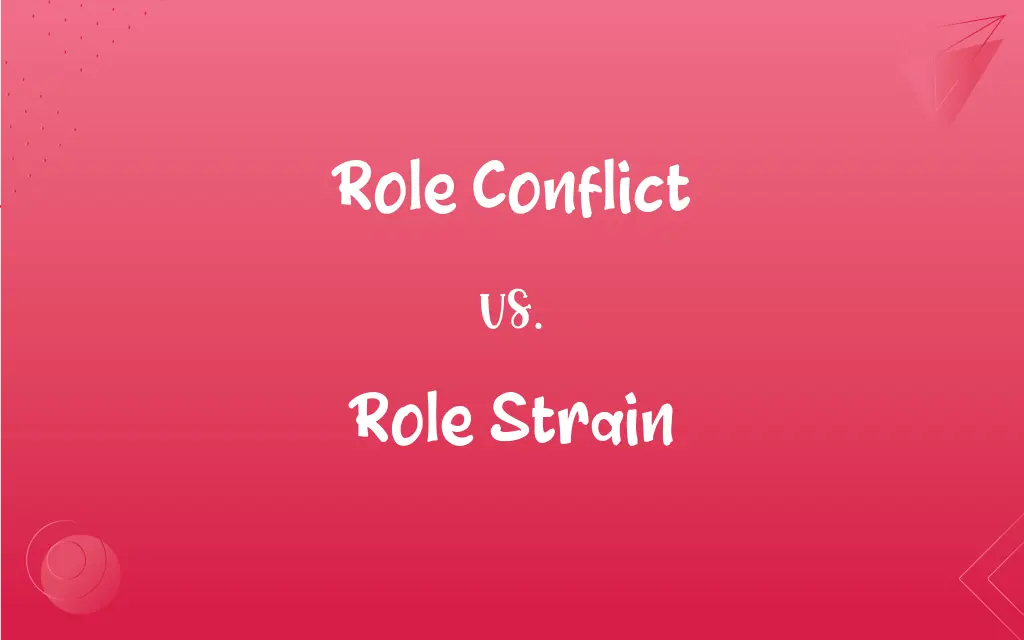Role Conflict vs. Role Strain: What's the Difference?
Edited by Aimie Carlson || By Janet White || Published on April 3, 2024
Role conflict occurs when the expectations of two or more roles are incompatible, while role strain involves tension within a single role due to conflicting demands.

Key Differences
Role conflict arises when an individual faces incompatible demands from different roles they occupy, such as being a parent, employee, or friend. These roles often have expectations that are difficult to satisfy simultaneously, leading to stress and dilemma. On the other hand, role strain describes the difficulty in fulfilling multiple obligations or expectations within a single role, stemming from a lack of resources, time, or energy, rather than from competing role expectations.
An example of role conflict is when a person's duty as a parent interferes with their responsibilities as an employee, such as needing to take care of a sick child during an important work meeting. Conversely, role strain might be experienced by a teacher who struggles to balance the needs of students, administrative tasks, and continuing education requirements, all of which are demands of the single role of being a teacher.
Role conflict often requires individuals to prioritize one role over another, making decisions that can lead to guilt or dissatisfaction due to neglecting aspects of another important role. In contrast, role strain might lead an individual to feel overwhelmed or inadequate within a single role, as they attempt to meet all its demands without sufficient resources.
Mitigating role conflict typically involves negotiation, delegation, or restructuring of roles and responsibilities to manage expectations more effectively across different areas of life. For role strain, solutions might include seeking support, improving time management skills, or adjusting the expectations of the role itself to make them more achievable.
Both role conflict and role strain can significantly impact an individual's mental health, satisfaction, and performance in their roles. Understanding the distinction between the two can help in identifying appropriate strategies for coping with and reducing the stress associated with each.
ADVERTISEMENT
Comparison Chart
Definition
Occurs when there are incompatible demands between two or more roles.
Occurs when there are conflicting demands within a single role.
Source of Conflict
Arises from the external conflict between different roles.
Arises from internal conflict within the demands of a single role.
Examples
Parental duties vs. work responsibilities.
Balancing teaching, administrative tasks, and personal development.
Resolution Strategies
Prioritization, negotiation, and role restructuring.
Seeking support, time management, and adjusting expectations.
Emotional Impact
Can lead to guilt or dissatisfaction from neglecting roles.
May cause feelings of overwhelm or inadequacy within the role.
ADVERTISEMENT
Focus
Managing expectations across different areas of life.
Enhancing ability to fulfill multiple obligations of a single role.
Role Conflict and Role Strain Definitions
Role Conflict
Necessitates negotiation and prioritization.
Discussing flexible work hours with an employer to accommodate parenting duties.
Role Strain
Involves tension from multiple demands within a single role.
A nurse dealing with patient care, paperwork, and staff shortages.
Role Conflict
Occurs when different roles have incompatible expectations.
A manager who is also a student may struggle to meet work deadlines and study for exams.
Role Strain
Requires internal adjustments and support.
Seeking mentorship to handle teaching responsibilities more effectively.
Role Conflict
Requires balancing or choosing between roles.
Choosing between attending a child's recital or a mandatory work meeting.
Role Strain
Leads to feeling overwhelmed within the role.
A volunteer feeling stretched thin by too many commitments.
Role Conflict
Impacts personal and professional life.
Strained relationships at home due to excessive work travel.
Role Strain
Affects performance and satisfaction in the role.
Decreased job satisfaction due to unmanageable workload.
Role Conflict
Can lead to stress and difficult decisions.
Feeling torn between professional responsibilities and family obligations.
Role Strain
Can result from unrealistic expectations.
Expecting to always be available for family, leading to exhaustion.
FAQs
How can one manage role conflict?
Managing role conflict involves prioritizing roles, negotiating role expectations, and possibly restructuring roles to reduce incompatibilities.
How can role strain be alleviated?
Alleviating role strain may require seeking support, improving time management and organizational skills, and adjusting role expectations to be more realistic.
What is role conflict?
Role conflict occurs when an individual faces incompatible demands from two or more of their social roles, leading to stress and difficult decision-making.
What is role strain?
Role strain refers to the stress and tension experienced within a single role due to conflicting or excessive demands.
Can role conflict and role strain occur simultaneously?
Yes, an individual can experience both role conflict and role strain simultaneously, facing incompatible demands between roles and within a single role.
What are the implications of role conflict and role strain for mental health?
Both can lead to increased stress, anxiety, and depression, affecting an individual's overall well-being and mental health.
How do role conflict and role strain differ in their impact on relationships?
Role conflict can strain relationships across different areas of life due to neglected roles, while role strain may affect relationships within a specific context, such as work or family, due to stress and frustration.
How do societal expectations influence role conflict and role strain?
Societal expectations can exacerbate role conflict and strain by imposing traditional or rigid role definitions, increasing the pressure to meet diverse and sometimes conflicting standards.
What strategies are effective for balancing multiple roles?
Effective strategies include setting clear priorities, communicating openly about role expectations, and seeking flexibility in role obligations.
What role does communication play in managing role conflict and strain?
Open communication is crucial for negotiating role expectations, seeking support, and finding solutions to manage the demands of multiple roles effectively.
What is the difference between role overload and role strain?
Role overload refers to having too many roles or responsibilities at once, contributing to stress, whereas role strain focuses on the difficulties within a single role due to conflicting demands.
How can organizations help employees manage role conflict and strain?
Organizations can offer flexible work arrangements, provide resources for stress management, and foster a supportive work environment that acknowledges employees' multiple roles.
How do cultural differences impact perceptions of role conflict and strain?
Cultural differences can significantly impact perceptions of role conflict and strain, as cultural norms and values influence role expectations, the acceptability of expressing stress, and the strategies used for coping and resolution.
How does role conflict affect decision-making?
Role conflict can complicate decision-making by forcing individuals to weigh the implications of their choices across different roles, potentially leading to indecision or compromised decisions.
How can individuals prevent role conflict and strain from escalating?
Prevention strategies include proactive planning, setting realistic expectations, communicating needs and limits, and regularly reassessing and adjusting role commitments.
What strategies can couples use to manage role conflict and strain?
Couples can manage role conflict and strain by practicing open communication, sharing responsibilities, supporting each other's roles, and negotiating expectations to find a balance that works for both partners.
What psychological theories address role conflict and role strain?
Theories such as role theory and the stress process model address role conflict and role strain by examining how roles influence behavior, stress, and coping mechanisms.
What role do boundaries play in managing role conflict and strain?
Setting clear boundaries between different roles can help manage role conflict and strain by preventing roles from interfering with each other and reducing the pressure from competing demands.
Can role conflict lead to positive outcomes?
Yes, navigating role conflict can lead to personal growth, improved problem-solving skills, and better time management, as individuals learn to balance competing demands effectively.
How can role conflict and strain influence work-life balance?
Role conflict and strain can negatively impact work-life balance by making it challenging to fulfill responsibilities in both domains, leading to stress and reduced quality of life.
About Author
Written by
Janet WhiteJanet White has been an esteemed writer and blogger for Difference Wiki. Holding a Master's degree in Science and Medical Journalism from the prestigious Boston University, she has consistently demonstrated her expertise and passion for her field. When she's not immersed in her work, Janet relishes her time exercising, delving into a good book, and cherishing moments with friends and family.
Edited by
Aimie CarlsonAimie Carlson, holding a master's degree in English literature, is a fervent English language enthusiast. She lends her writing talents to Difference Wiki, a prominent website that specializes in comparisons, offering readers insightful analyses that both captivate and inform.































































